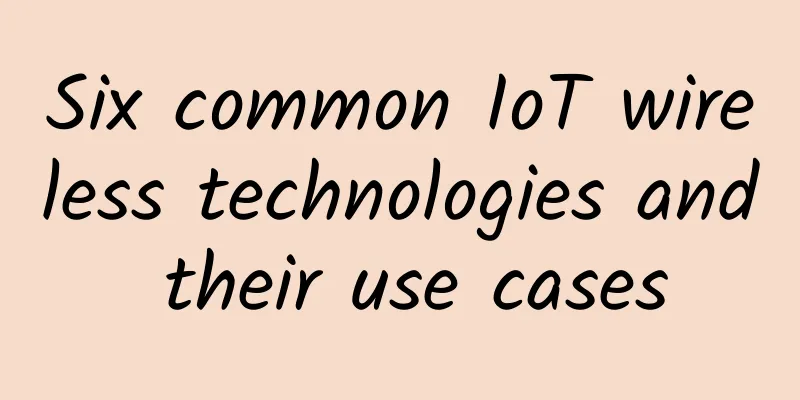Six common IoT wireless technologies and their use cases

|
The Internet of Things (IoT) starts with network connectivity, but because IoT is such a broad and diverse field, you certainly won’t find a one-size-fits-all communication solution. In this article, we’ll look at six common IoT wireless technologies.
1. Low Power Wide Area Network (LPWAN) Low-power wide-area networks are the new phenomenon in the Internet of Things. This family of technologies is designed to support large-scale IoT applications across industry, commerce, and campuses by providing long-range communications services for years using small, inexpensive batteries. LPWANs can connect nearly all types of IoT sensors, facilitating numerous applications from remote monitoring, smart metering and worker safety to building control and facility management. However, LPWANs can only send small chunks of data at low rates, making them more suitable for use cases that do not require high bandwidth and are not time-sensitive. Also, again, not all LPWANs are created equal. Today, there are licensed LPWAN technologies (NB-IoT, LTE-M) and unlicensed LPWAN technologies (e.g., MIOTY, LoRa, Sigfox, etc.). These technologies perform to varying degrees in key network factors, for example, power consumption is a major concern for licensed cellular-based LPWANs, while quality of service and scalability are major concerns when adopting unlicensed technologies. Additionally, standardization is another important factor to consider if you want to ensure long-term reliability, security, and interoperability. 2. Cellular (3G/4G/5G) Cellular mobile networks are well-entrenched in the consumer market, providing reliable broadband communications and supporting a wide range of voice calling and streaming video applications. The downside is that they come with very high operating costs and power requirements. While cellular networks are not suitable for most battery-powered sensor IoT applications, they are well suited for specific use cases, such as connected cars or fleet management in transportation and logistics. In addition, services such as in-vehicle infotainment, traffic routing, advanced driver assistance systems (ADAS), and fleet telematics and tracking services can all rely on the ubiquitous high-bandwidth cellular networks. 5G, the next generation of mobile networks with high speed and ultra-low latency, will be the future of self-driving cars and augmented reality (VR). 5G is also expected to enable real-time video surveillance for public safety, real-time mobile transmission of medical data sets for connected health, and some time-sensitive industrial automation applications. Zigbee and other mesh protocols Zigbee is a short-range, low-power wireless technology (IEEE 802.15.4) that is typically deployed in a mesh topology to extend coverage by relaying sensor data across multiple sensor nodes. Compared to low-power wide-area networks, zigbee offers higher data rates, but at the same time suffers from reduced energy efficiency due to the mesh configuration. Due to their short physical range (<100m), Zigbee and similar mesh protocols (such as Z-Wave, Thread, etc.) are best suited for mid-range IoT applications where nodes are evenly distributed and in close proximity. In general, Zigbee is a perfect complement to WI-FI for a variety of home automation applications such as smart lighting, HVAC control, security, and energy management. Before the advent of LPWAN, mesh networks were also implemented in industrial environments to support a variety of remote monitoring solutions. However, they are far from ideal for many geographically dispersed industrial facilities, and their theoretical scalability is often limited by the increasing complexity of network setup and management. 4. Bluetooth and BLE Bluetooth belongs to the category of personal wireless networks and is a short-range communication technology that is well positioned in the consumer market. The new Bluetooth low energy, due to its low power consumption characteristics, further optimizes consumer IoT applications. BLE-enabled devices are primarily used in conjunction with electronic devices, typically smartphones, which act as hubs for transmitting data to the cloud. Today, BLE is widely integrated in fitness and medical wearables (such as smart watches, blood glucose meters, pulse oximeters, etc.) and smart home devices (such as door locks), through which data can be conveniently transmitted to and visualized on smartphones. In retail environments, BLE can be combined with beacon technology to enhance customer services such as in-store navigation, personalized promotions, and content delivery. 5. Wi-Fi and Wi-Fi HaLow Wi-Fi (IEEE 802.11a/b/g/n) really needs no explanation given its widespread use in enterprise and home environments. However, in the world of IoT, Wi-Fi plays a less important role. Except for a few applications such as digital signage and indoor surveillance cameras, Wi-Fi is not a viable solution for connecting IoT terminal devices because it has major limitations in coverage, scalability and power consumption. (Source: IoT Home Network) Instead, the technology can serve as a backend network to transmit aggregated data from a central IoT center to the cloud, especially in smart homes. Serious security issues often hinder its application in industrial and commercial use cases. A new, lesser-known derivative of Wi-Fi - Wi-Fi HaLow (IEEE 802.11 ah) - brings significant improvements in range and energy efficiency to meet a wider range of IoT use cases. Despite this, the technology has received little attention and industry support so far, partly due to its low security. HaLow also operates on the 900 MHz band that is only available in the United States, making it far from a global solution. 6. RFID Radio Frequency Identification (RFID) uses radio waves to transmit small amounts of data from an RFID tag to a reader over a very short distance. To date, this technology has driven a major revolution in the retail and logistics sectors. By attaching RFID tags to various products and equipment, companies can track their inventory and assets in real time, enabling better inventory and production planning and optimized supply chain management. As IoT applications continue to increase, RFID continues to consolidate its position in the retail industry, making IoT applications such as smart shelves, self-checkout and smart mirrors possible. In summary, each IoT vertical and application has its own unique network requirements. Selecting the best wireless technology for your IoT use case means accurately balancing criteria in terms of range, bandwidth, quality of service, security, power consumption, and network management. |
<<: Practice: How to connect two routers through WAN and LAN ports respectively?
>>: HTTP 3: Past, Present, and Early Adoption
Recommend
Inspur Network Electronics Range Training Base officially launched
Recently, the "Inspur Network Electronic Tar...
What is the difference between Cookie and Session in HTTP protocol?
HTTP is a stateless protocol, that is, each time ...
What is the appropriate number of Goroutines? Will it affect GC and scheduling?
[[387141]] This article is reprinted from the WeC...
All websites must complete IPv6 transformation by the end of the year? MIIT responds
Today, according to the official WeChat account o...
[Black Friday] spinservers: $270 off San Jose high-end servers, dual E5-2683 v4, 512G memory, 2*3.83T SSD, 10Gbps bandwidth
There are still a few days before Black Friday, a...
In-depth | Only IT people can understand "Journey to the West"
As a TV series that has been rebroadcast thousand...
SaltyfishTech: San Jose CN2 GIA line VPS quarterly payment starting from $15.9, 1GB/10G SSD/1TB@300Mbps
SaltyfishTech recently offered a 7.8 discount cod...
How NFV systems converge virtual network services at the edge
Think back to the days before smartphones, when p...
Thoughts behind "Mobile Internet Users and All-Netcom Sales Both Exceed 700 Million"
According to the latest report released by China ...
Yan Lida, President of Huawei Enterprise BG: Achieving Dreams and Creating Infinite Possibilities
On September 7, the third day of the All-Connect ...
Four factors driving 100Gbps network upgrades
According to Crehan Research, 100Gbps and 25Gbps ...
The transformation path of communication engineers in the 5G era
[[263696]] The 5G era is an era of great integrat...
How to balance the development of Wi-Fi 7 and future 5G/6G?
As society progresses, people's demand for in...
How to Choose the Right Switch for Your Network?
When it comes to networking, switches are crucial...









